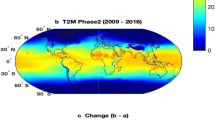Abstract
To provide a simple high-resolution heat-stress forecast for Seoul, Korea, we coupled a high-resolution climate simulation (25 m grid spacing) for an average heat day with the operational forecasting model (5 km grid spacing). Thereby, we accounted for the meso-scale weather conditions and local-scale air temperature induced by land cover and the urban heat island effect. Moreover, we estimated the impacts of heat events using heat-related mortality rate. Applying the simple high-resolution heat-stress forecast for July and August 2016, we detected a substantial spatial variability in maximum air temperature and heat-related mortality rate in Seoul. The evaluation of simulated maximum air temperature compared to observations revealed a small deviation (MB = 0.11 K, RMSD = 1.40 K). Despite the limitation of using average conditions, it was an efficient way to identify particularly affected areas, neighbourhoods, and districts for releasing more location-specific heat-stress warnings.






Similar content being viewed by others
References
Arnfield AJ (2003) Two decades of urban climate research: a review of turbulence, exchanges of energy and water, and the urban heat island. Int J Climatol 23:1–26. https://doi.org/10.1002/joc.859
Best MJ (2006) Progress towards better weather forecasts for city dwellers: from short range to climate change. Theor Appl Climatol 84:47–55. https://doi.org/10.1007/s00704-005-0143-2
Buchin O, Jänicke B, Meier F, Scherer D, Ziegler F (2016) The role of building models in the evaluation of heat-related risks. Nat Hazards Earth Syst Sci 16:963–976. https://doi.org/10.5194/nhess-16-963-2016
Hajat S, Kosatky T (2010) Heat-related mortality: a review and exploration of heterogeneity. J Epidemiol Community Health 64:753–760
Heusinkveld BG, Sterenborg G, Steeneveld GJ, Attema JJ, Ronda RJ, Holtslag AAM (2017) Smartphone app brings human thermal comfort forecast in your hands. BAMS, December:2533–2541. doi:https://doi.org/10.1175/BAMS-D-16-0082.1
Jänicke B, Holtmann A, Kim KR, Kang M, Fehrenbach U, Scherer D (2019) Quantification and evaluation of intra-urban heat stress variability in Seoul, Korea. Int J Biometeorol 63:1–12. https://doi.org/10.1007/s00484-018-1631-2
Karimi M, Vant-Hull B, Nazari R, Mittenzwei M, Khanbilvardi R (2017) Predicting surface temperature variation in urban settings using real-time weather forecasts. Urban Clim 20:192–201. https://doi.org/10.1016/j.uclim.2017.04.008
Keramitsoglou I, Sismanidis P, Analitis A, Butler T, Founda D, Giannakopoulos C, Giannatou E, Karali A, Katsouyanni K, Kendrovski V, Lemesios G, Myrivili E, Ordoñez D, Varotsos KV, Vlastou G, Kiranoudis CT (2017) Urban thermal risk reduction: developing and implementing spatially explicit services for resilient cities. Sustain Cities Soc 34:56–68. https://doi.org/10.1016/j.scs.2017.06.006
Kim Y-H, Baik J-J (2002) Maximum urban heat island intensity in Seoul. J Appl Meteorol 41:651–659
Kim Y-H, Baik J-J (2005) Spatial and temporal structure of the urban heat island in Seoul. J Appl Meteorol 44:591–605
Kim E-J, Kim H (2017) Effect modification of individual- and regional-scale characteristics on heat wave-related mortality rates between 2009 and 2012 in Seoul, South Korea. Sci Total Environ 595:141–148. https://doi.org/10.1016/j.scitotenv.2017.03.248
Kim H, Ha J, Park J (2006) High temperature, heat index, and mortality in n6 major cities in South Korea. Arch Environ Occup Health 61:265–270
Kim KR, Yi C, Lee J-S, Meier F, Jänicke B, Fehrenbach U, Scherer D (2014) BioCAS: biometeorological climate impact assessment system for building-scale impact assessment of heat-stress related mortality. Die Erde 145:62–79. https://doi.org/10.12854/erde-145-6
Kim CT, Lim Y-H, Woodward A, Kim H (2015) Heat-attributable deaths between 1992 and 2009 in Seoul, South Korea. PLoS One 10(2):1–14. https://doi.org/10.1371/journal.pone.0118577
Kovats RS, Hajat S (2008) Heat Stress and Public Health: A Critical Review. Annu Rev Public Health 29:41–55
Memon AR, Leung DYC, Chunho LIU (2008) A review on the generation, determination and mitigation of urban heat island. J Environ Sci 20:120–128
Park H-S (1986) Features of the heat island in Seoul and its surrounding cities. Atmos Environ 20:1859–1866
Perego S (1999) Metphomod - a numerical mesoscale model for simulation of regional photosmog in complex terrain: model description and application during pollumet 1993 (Switzerland). Meteorology and Atmospheric Physic 70:43–69
Petkova EP, Morita H, Kinney PL (2014) Health impacts of heat in a changing climate: how can emerging science inform urban adaptation planning? Curr Epidemiol Rep 1:67–74. https://doi.org/10.1007/s40471-014-0009-1
Reid CE, O’Neill MS, Gronlund CJ, Brines SJ, Brown DG, Diez-Roux AV, Schwartz J (2009) Mapping community determinants of heat vulnerability. Environ Health Perspect 117(11):1730–1736. https://doi.org/10.1289/ehp.0900683
Ronda RJ, Steeneveld GJ, Heusinkveld BG, Attema JJ, Holtslag AAM (2017) Urban finescale forecasting reveals weather conditions with unprecedented detail. Bull Amer Meteor Soc 98:2675–2688. https://doi.org/10.1175/BAMS-D-16-0297.1
Scherer D, Fehrenbach U, Lakes T, Lauf S, Meier F, Schuster C (2013) Quantification of heat-stress related mortality hazard, vulnerability and risk in Berlin, Germany. Die Erde 3–4:238–259. https://doi.org/10.12854/erde-144-17
Seo YK, Choi JT, Yang JK (2006) Development of air temperature forecast model and operational system using MOS. Korea Meteorological Administration DFS-TN-2006-5:189
Taylor J, Wilkinson P, Davies M, Armstrong B, Chalabi Z, Mavrogianni A, Symonds P, Oikonomou E, Bohnenstengel SI (2015) Mapping the effects of urban heat island, housing, and age on excess heat-related mortality in London. Urban Clim 14:517–528. https://doi.org/10.1016/j.uclim.2015.08.001
Tomlinson CJ, Chapman L, Thornes JE, Baker CJ (2011) Including the urban heat island in spatial heat health risk assessment strategies: a case study for Birmingham, UK. Int J Health Geogr 10:1–14
Yi C, Kim KR, An SM, Choi Y-J, Holtmann A, Jänicke B, Fehrenbach U, Scherer D (2015) Estimating spatial patterns of air temperature at building-resolving spatial resolution in Seoul, Korea. Int J Climatol 36:533–549. https://doi.org/10.1002/joc.4363
Yi C, Shin Y, Roh J-W (2018) Development of an urban high-resolution air temperature forecast system for local weather information services based on statistical downscaling. Atmosphere 9(164):1–21. https://doi.org/10.3390/atmos9050164
Funding
This research was supported by the “Research and Development for KMA Weather, Climate, and Earth System Services: Biometeorology” of the National Institute of Meteorological Sciences of the KMA.
Author information
Authors and Affiliations
Corresponding author
Additional information
Publisher's note
Springer Nature remains neutral with regard to jurisdictional claims in published maps and institutional affiliations.
Rights and permissions
About this article
Cite this article
Jänicke, B., Kim, K.R. & Cho, C. A simple high-resolution heat-stress forecast for Seoul, Korea: coupling climate information with an operational numerical weather prediction model. Int J Biometeorol 64, 1197–1205 (2020). https://doi.org/10.1007/s00484-020-01893-1
Received:
Revised:
Accepted:
Published:
Issue Date:
DOI: https://doi.org/10.1007/s00484-020-01893-1




